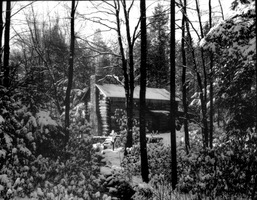 | Back to e-WV
| Back to e-WV
 The West Virginia Encyclopedia
The West Virginia Encyclopedia
 | Back to e-WV
| Back to e-WV
 The West Virginia Encyclopedia
The West Virginia Encyclopedia

Youghiogheny Forest Colony, a historic artists colony originally consisting of 12 log cabins, is located near the West Virginia-Maryland state line on U.S. 50 in Preston County. Initially including about 100 acres of old-growth hemlock and hardwood forest, the property was purchased in 1929 by Frank Reeves. The colony is on the headwaters of the Youghiogheny River, which originates nearby.
Reeves, born in 1886 in Fairmont, attended West Virginia University, received a Ph.D. from Johns Hopkins University (1916), and traveled the world as a geologist. He is noted for being the first to survey the famous Wolf Creek Crater in Australia. To construct the colony, Reeves worked with local craftsmen to cut timber and build the cabins and a tavern. While some of the buildings were primitive, the Gravens’ cabin (designed by Clarksburg native Thomas Hood, 1940) was distinctively stylish, with a round copper-roofed kitchen and a tall glass-brick window. Constructed for summer use, the cabins were nevertheless occupied year-round during the Depression by Washington-area artists, writers, doctors, architects, and musicians. Many of them were of European origin and friends of Reeves’s wife, Lottie.
The Tavern, a substantial log building, was the first structure to be built (1930). The colony’s artists, including WPA muralist Robert Gates, painter Joe Goethe, architects Arved Kundzin and Thomas Hood, and photographer Volkmar Wentzel, often displayed their artwork on its walls. Eleanor Roosevelt, traveling U.S. 50 to visit Arthurdale, stopped at the Tavern. Her purchase of Wentzel’s postcards inspired him to pursue his interest in photography, leading to a life-long career with National Geographic.
While Youghiogheny Forest Colony is still spoken of as an ‘‘artists colony,’’ in reality this informal gathering of artists existed for only those years prior to World War II. The Forest has seen many changes, including devastating fires, re-buildings, and studios abandoned to the forest’s overgrowth.
Written by Michele Mouré